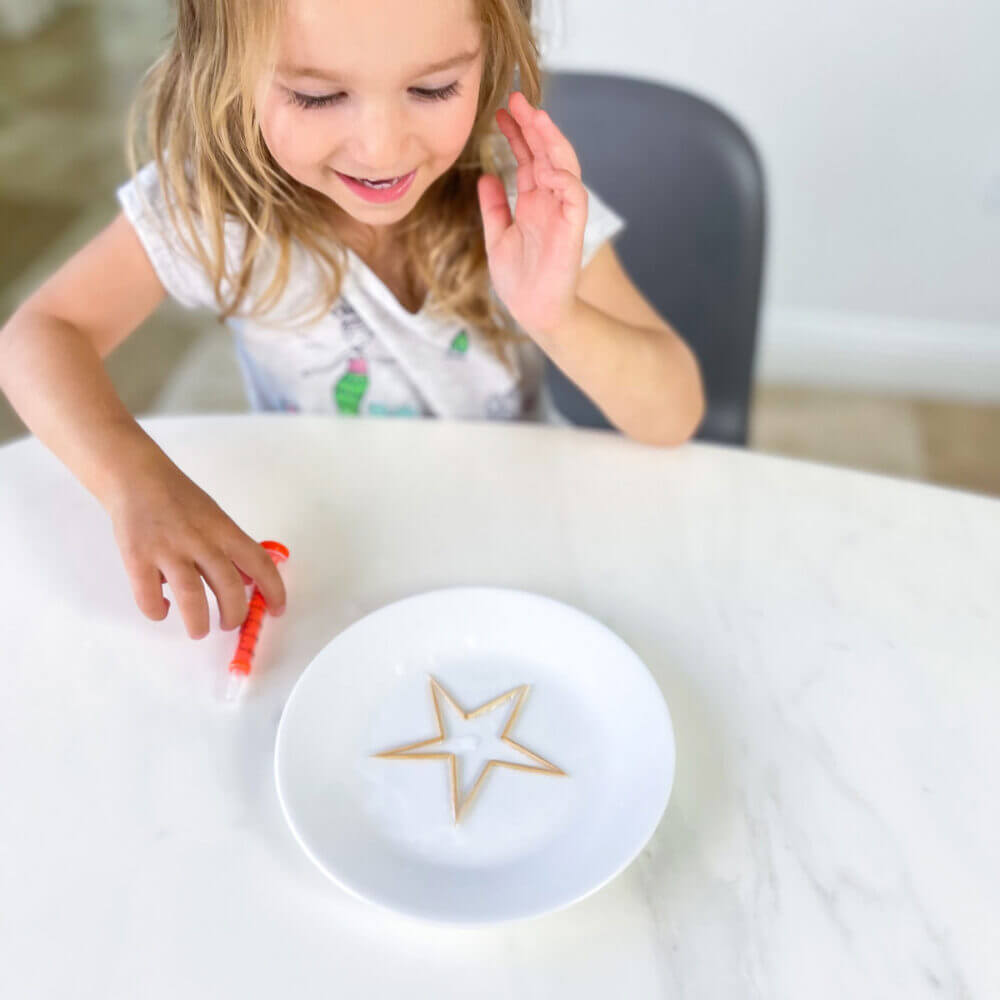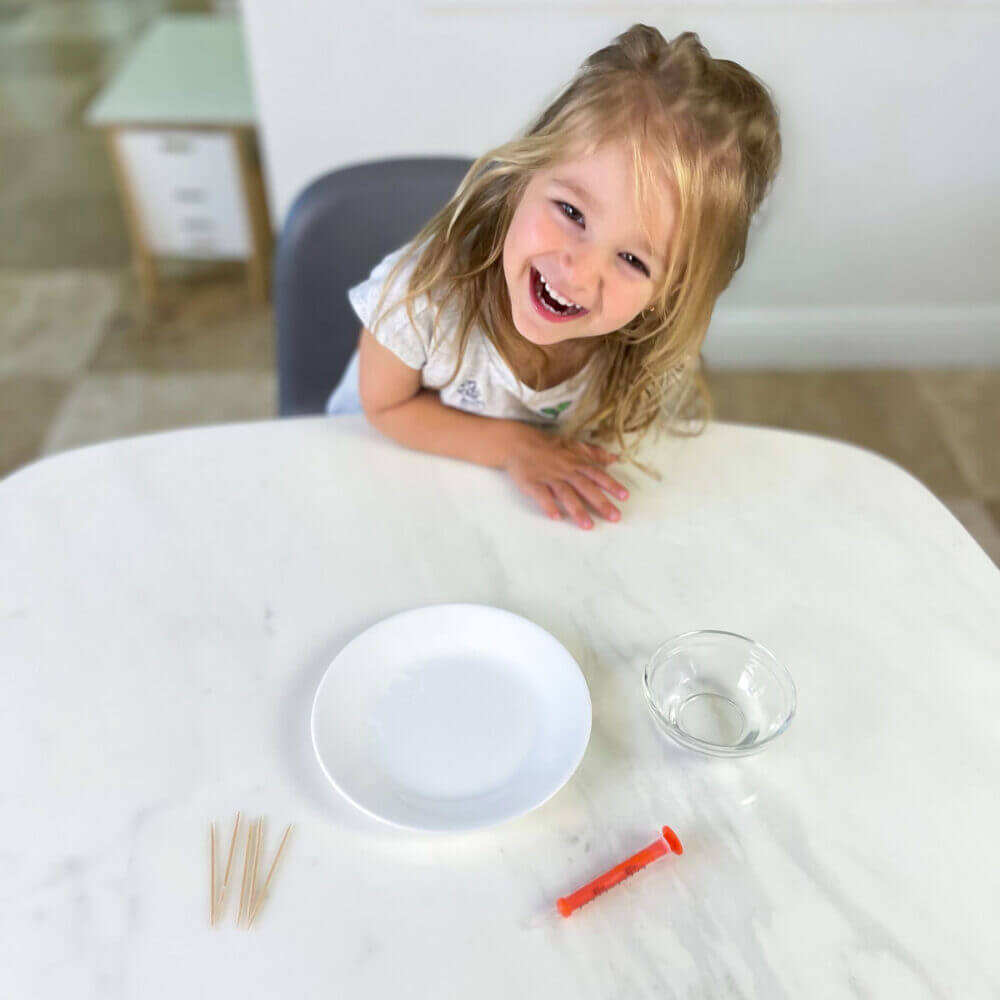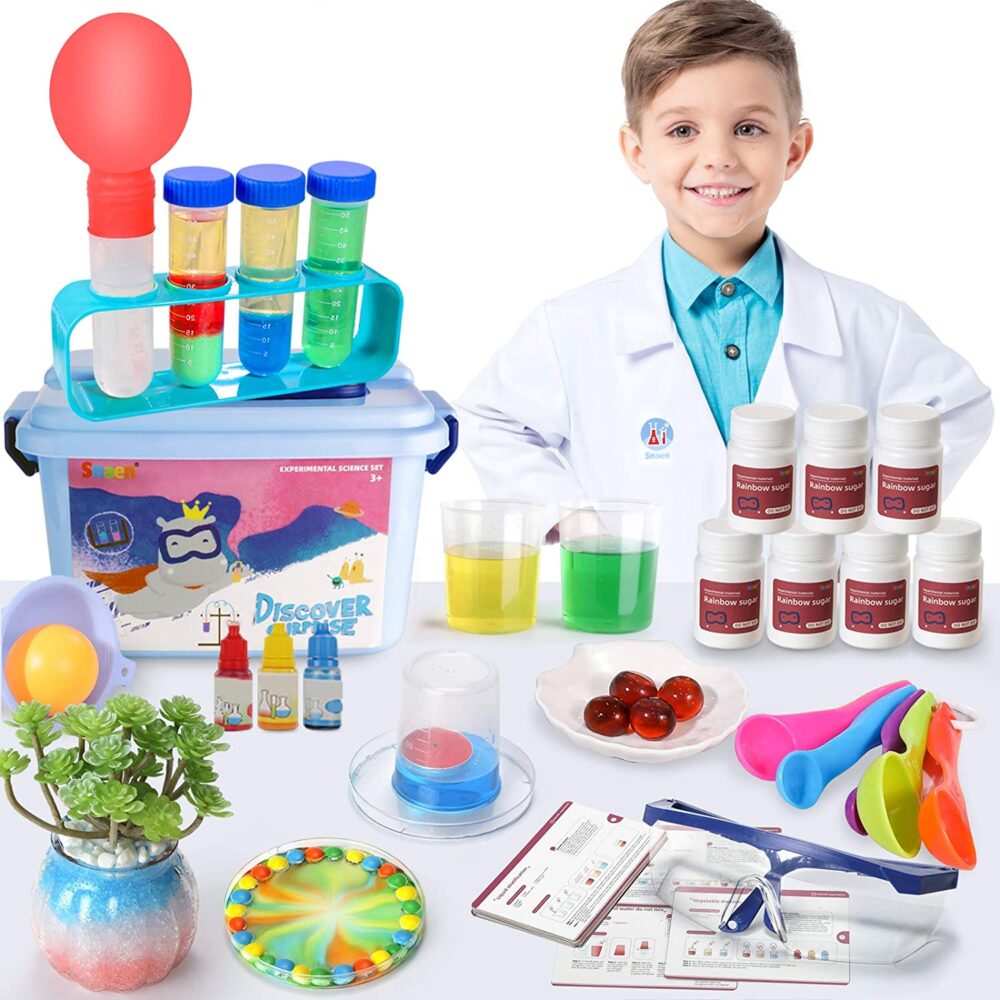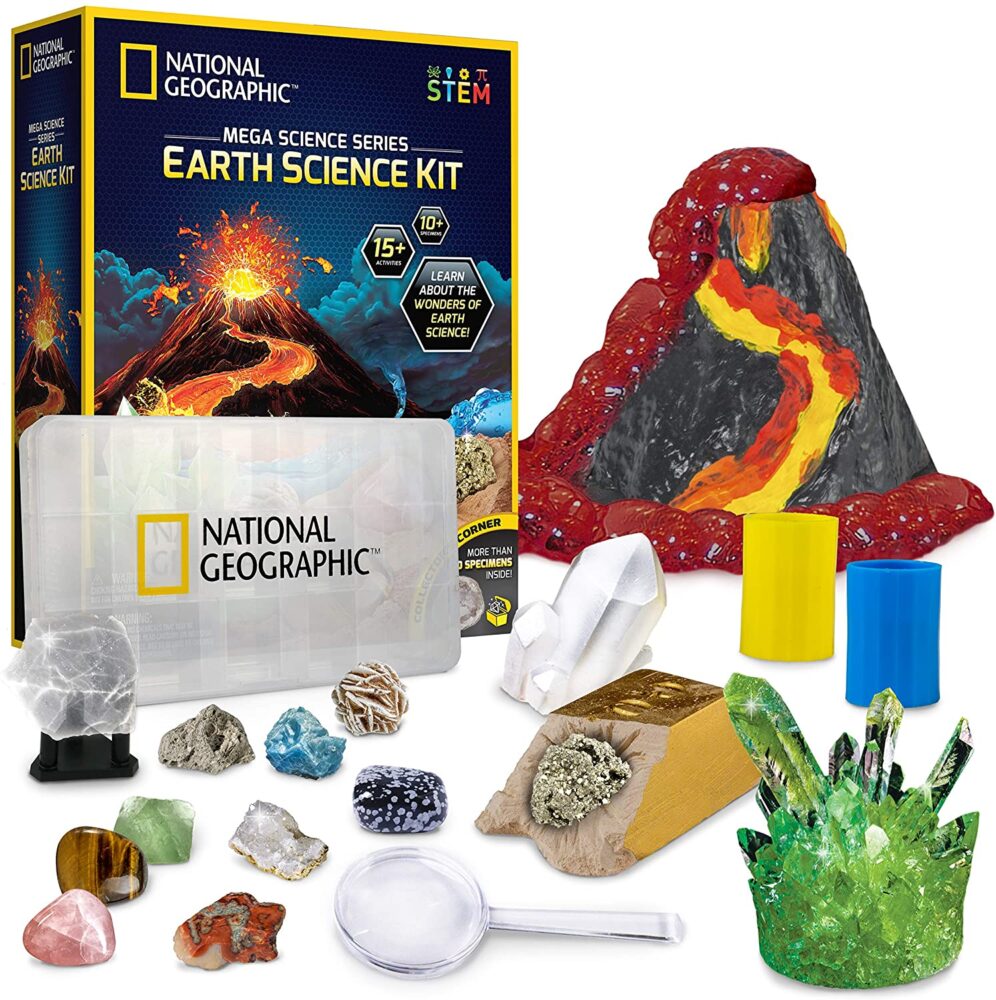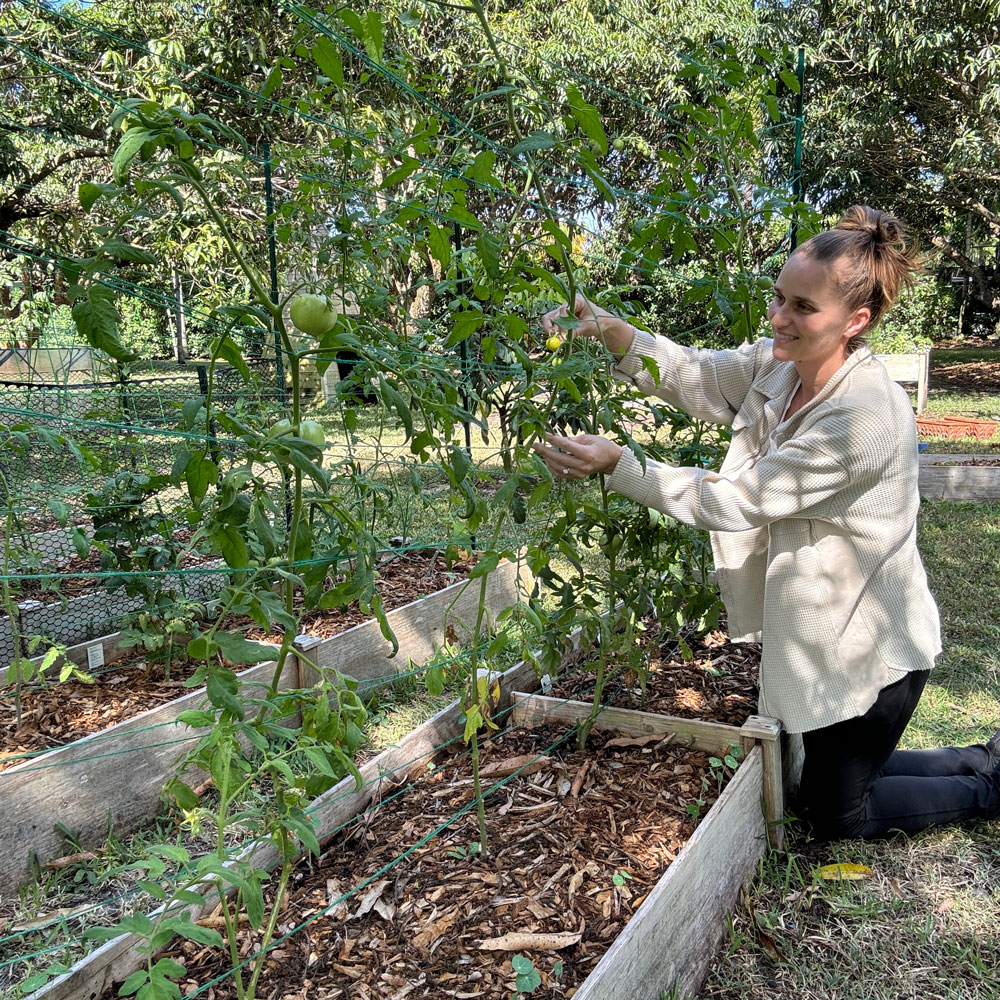Toothpick Star Science – Magic with Water
This toothpick star science experiment is just like magic! Best part? Your kiddo will learn all about absorption and capillary action! Plus, setting this up is so simple – you only need a few supplies. Read on to find out how you can do this too!
This Star Science Experiment is Fun for All Ages
This activity is so mesmerizing that even though it takes seconds to set up, kids are going to want to do it over and over again. While older kids can enjoy learning about the science (more about that below!). Younger kids can still have fun with this! It takes a lot of coordination to set up those small toothpicks and to carefully pour the water – these actions are great for toddler and preschool fine motor skills!
For even more simple science experiments you can do at home visit our comprehensive list of science experiments!
All activities should be supervised by an adult. As an Amazon Associate, I earn from qualifying purchases. This post may contain affiliate links.
How to Make This Star Experiment
Assuming you grab the right type of toothpicks, this may be one of the easiest activities you set up with your kiddos! So simple that once you do it once, they’re going to be able to take over and show you how it’s done. Talk about a great way to give them the confidence to show off their creative skills, too!
In this video you can see how everything gets set up. Depending on your toothpicks, the experiment can work quickly or slowly – it’s all about absorption!
How to Make This Star Experiment
Assuming you grab the right type of toothpicks, this may be one of the easiest activities you set up with your kiddos! So simple that once you do it, they’re going to be able to take over and show you how it’s done. Talk about a great way to give them the confidence to show off their creative skills, too!
In this video you can see how everything gets set up. Depending on your toothpicks, the experiment can work quickly or slowly – it’s all about absorption!
Tips for This Toothpick Star Experiment
Who knew broken toothpicks and water could be so much fun?! To avoid this experiment being frustrating instead of fun, be sure to follow these important tips!
Choose the Right Toothpick. Based on our own experience, we discovered that not all toothpicks are alike! Bamboo toothpicks, for example, did not work for us. They simply did not absorb the water the same way a birch wood toothpick did. Also, make sure each end is pointy!
Make a Clean Break, But Don’t Break in Half. When snapping the toothpick, you must not break it all the way through. The wooden pieces must still be connected, but you’ll want to make sure you don’t have too many frays. This can be fixed by easily trimming the frays away.
Slowly Add the Water. After you place all the broken toothpicks in place, you’ll want to be gentle when adding the water. If not, you risk moving and misplacing all of the toothpicks before the experiment has even begun!
Materials
- Toothpicks
- Plate
- Water
- Water Dropper
- Toothpicks
- Water
- Plate
- Water dropper
Step-by-Step Instructions
Step 1
Snap 5 toothpicks in the center, but do not break them fully. Make sure there is still a center hinge and it can form a “V” shape.
Step 2
Arrange the toothpicks in the center of a plate. Make sure the sides are symmetrically touching each other.
Step 3
Use a dropper and slowly add water into the center of the arranged toothpicks. You will only need a few drops. Feel free to add more if the star appears to stop moving, but do not add so much that the toothpicks are fully immersed.
Step 4
Watch as the toothpicks slowly move, absorbing water, to form a star shape!
Step 1
Snap 5 toothpicks in the center, but do not break them fully. Make sure there is still a center hinge and it can form a “V” shape.
Step 2
Arrange the toothpicks in the center of a plate. Make sure the sides are symmetrically touching each other.
Step 3
Use a dropper and slowly add water into the center of the arranged toothpicks. You will only need a few drops. Feel free to add more if the star appears to stop moving, but do not add so much that the toothpicks are fully immersed.
Step 4
Watch as the toothpicks slowly move, absorbing water, to form a star shape!
The Educational Benefits of the Toothpick Star Experiment
For early learners, this is a great activity to talk about the shapes and points of a star. They can count the star tips and then try and draw one on their own, too. Plus, as I mentioned earlier, breaking the toothpicks, arranging them, and using the dropper are all valuable fine motor skill exercises!
Older kids will be able to learn more about the science behind this fun activity which is by a process known as capillary action. Capillary action is the ability of a liquid to flow in narrow spaces against gravity. Capillaries are found in plants, like the wood made from the toothpicks! The wood absorbs the water and as it expands the bent wood straightens, pushing against the other allowing a star to form.
Use this example as a way to talk to them about capillaries that are found in plants as well and see if they can start to make that connection. It’s the perfect time to try this experiment with the kids, no matter their age!
The Educational Benefits of the Toothpick Star Experiment
For early learners, this is a great activity to talk about the shapes and points of a star. They can count the star tips and then try and draw one on their own, too. Plus, as I mentioned earlier, breaking the toothpicks, arranging them, and using the dropper are all valuable fine motor skill exercises!
Older kids will be able to learn more about the science behind this fun activity which is by a process known as capillary action. Capillary action is the ability of a liquid to flow in narrow spaces against gravity. Capillaries are found in plants, like the wood made from the toothpicks! The wood absorbs the water and as it expands the bent wood straightens, pushing against the other allowing a star to form.
Use this example as a way to talk to them about capillaries that are found in plants as well and see if they can start to make that connection. It’s the perfect time to try this experiment with the kids, no matter their age!
More Science Experiments to Explore!
Here are my top picks for science experiment kits!
This science kit for kids includes 30 scientific experiments plus fun gear like a lab coat, goggles, and other scientific equipment!
This 3-Pack Chemistry Kits will ignite a passion for science. Including an electrochemistry lab, fire lab, and vortex lab.
This kit lets your children learn hands-on about geology and chemical reactions in volcanoes.
Create glowing slime, fizzing reactions, oozing bubbles, colorful chromatography, and more!
What’s Next?
How to Make Kids Bath Paint – Colorful Clean Fun
Explore a fun and easy way to make bath time fun for kids with our vibrant and homemade kids bath paint recipe!
The Best Bath Toys for Kids in 2024
Explore the best bath toys for kids! Discover the ultimate guide to bath time fun with these top picks that will make every splash memorable.
How to Layer a Raised Garden Bed and Make a Trellis
Learn how to layer a raised bed and create affordable trellises for thriving gardens. Explore our guide for expert tips & easy instructions!

